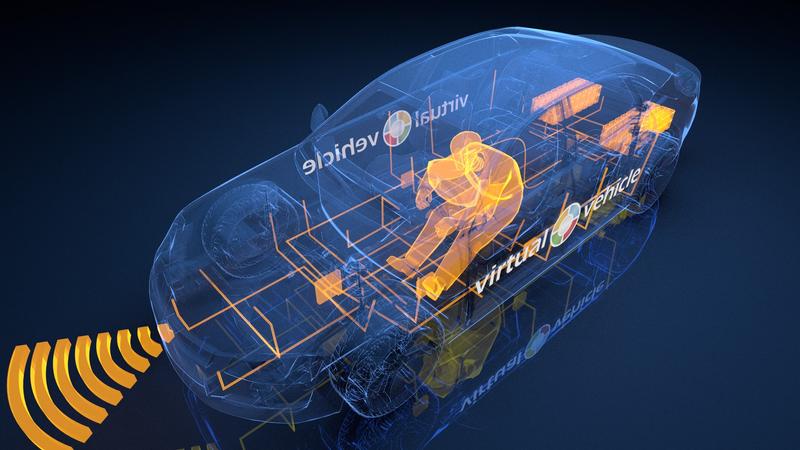A reactive human model increases traffic safety and helps crash test dummies do their job
Graz – Every day, nearly 75 people lose their lives on Europe’s roads. The Austrian VIRTUAL VEHICLE Research Center is developing a new human model for use in simulating accident scenarios. Research partners in this undertaking are the Graz University of Technology and industrial partners such as Audi, BMW, Daimler, Porsche and Volkswagen. This new model is able to simulate the movement of vehicle occupants more accurately than before, particularly in the moments just before impact, and in the long run will further improve vehicle safety systems. The numerical simulation model provides a virtual representation of the human body with its muscles with special focus on the pre-crash phase.
The automotive industry has invested heavily in the development of safety systems. In addition to continual improvements to passive systems such as seatbelts, high-tech seats and airbags, the trend is to work on active systems that recognize danger or on brake assistance. In this manner, the number of fatal traffic accidents could be significantly reduced. Despite these improvements, 75 people die on Europe’s roads per day. That is 75 too many. The European Commission has given itself the target of at least halving the number of fatalities by 2020.
So far, crash tests have typically been employed to test the effectiveness of passive safety systems. To this end dummies equipped with various sensors are subjected to crash tests and injury risks are derived from the measured loads. It is very important to not only examine the crash phase but also the pre-crash phase, because in the few seconds prior to the crash event, humans attempt to prepare themselves for impact with protective movements and muscle activity. This preparation results in the vehicle occupants having a very different position prior to impact compared to a normal situation. This in turn has significant effects on the protective function of safety systems such as airbag etc. Crash test dummies have not been able to take factors such as these into account. Simulations are especially useful in the development of active safety systems. The room for improvement in passive safety systems is practically exhausted.
Numerical Simulation Model for Integrated Safety
The numerical simulation of human kinematics in the pre-crash phase enables the realistic and virtual design of integrative safety systems that can intervene prior to impact. This intervention can significantly reduce the severity of the accident, if not even avoid it completely. Brake assistants, for example, use camera systems to recognize dangerous situations even before the driver becomes aware of them. Exact models that describe human behaviour during brake and steering manoeuvres in emergency situations are crucial in order to be able to develop such new, integrative safety systems.
VIRTUAL VEHICLE has developed the human model in order to recreate such reactive and intuitive movement in numerical simulations. This development enables automotive manufacturers and suppliers to improve their understanding of the kinematics of human vehicle occupants in accident scenarios and to incorporate their findings in the development of safety systems.
The big challenge in this project is to integrate two very different physical areas into a single numerical model. On the one hand, the “gentle” phase before the crash, and on the other the “hard” actual crash event itself with very high loads. A few seconds before impact, the occupants are only subjected to relatively low forces, depending on the frictional attributes of the tyres and the brake system, which permits a wide range of possible human reactions. However, during a crash event, very high accelerations within 100 milliseconds occur, which require optimised interactive cooperation between seatbelt, airbag and the vehicle interior.
Real Tests for Realistic Simulation
New vehicle tests were employed in order to obtain a realistic and representative set of data for the configuration of the simulation model. Instead of simple sled tests, the kinematic behaviour (movement capture) of 60 test subjects was directly determined for various emergency stop, lane change and combined manoeuvres in order to obtain genuinely realistic results. The kinematics of the vehicle, the occupant and the associated muscle activity were accurately measured and recorded.
The reactive human model OM4IS provides important support to the automotive industry for the development and design of integrated safety systems, for example the further development of emergency brake assistants, or the exact adaptation of airbag deployment to certain crash situations.
Currently, the new simulation model is in the further development and test phase together with the partnership for Dummy Technology and Biomechanics, represented by the cooperation platform of German automotive manufacturers Audi, BMW, Daimler, Porsche and Volkswagen. The system can also offer crucial answers to current questions relating to the development of highly automated or autonomous driving systems. How much braking force can be applied in an emergency situation, or how much swerving can be done during an avoidance manoeuvre, without endangering the passengers? The new simulation model is not only a valuable supplement for the simulation and forecast of passenger kinematics before a collision, but can also be a replacement for elaborate and expensive crash tests.
VIRTUAL VEHICLE’s new, reactive human model will play a major role in increasing safety on the roads and is a huge step towards the EU’s ambitious target of halving the number of traffic fatalities by the year 2020. The project, which has been running since March 2009, has recently been nominated for the prestigious business award from the province of Steiermark, the “Austrian Fast Forward Award”.
Weitere Informationen:
http://www.v2c2.at - VIRTUAL VEHICLE Research Center
Die semantisch ähnlichsten Pressemitteilungen im idw



